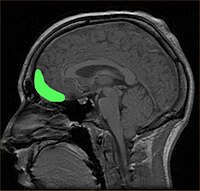
Photo from wikipedia
Prior research suggests that a traitlike tendency to experience impulsivity during states of high emotion is robustly associated with many forms of psychopathology. Several studies tie emotion-related impulsivity to response… Click to show full abstract
Prior research suggests that a traitlike tendency to experience impulsivity during states of high emotion is robustly associated with many forms of psychopathology. Several studies tie emotion-related impulsivity to response inhibition deficits, but these studies have not focused on the role of emotion or arousal within subjects. The present study tested whether arousal, measured by pupil dilation, amplifies deficits in response inhibition for those high in emotion-related impulsivity. Participants (N = 85) completed a measure of emotion-related impulsivity, underwent a positive mood induction procedure that reduced heterogeneity in mood states, and completed a response inhibition task. Pupil dilation was used to index arousal during the response inhibition task. Generalized linear mixed effect modeling yielded the hypothesized interaction between arousal (pupil dilation) and emotion-related impulsivity in predicting response inhibition performance at the trial level. Emotion-related impulsivity relates to more difficulties with response inhibition during moments of high arousal.
Journal Title: Psychophysiology
Year Published: 2019
Link to full text (if available)
Share on Social Media: Sign Up to like & get
recommendations!